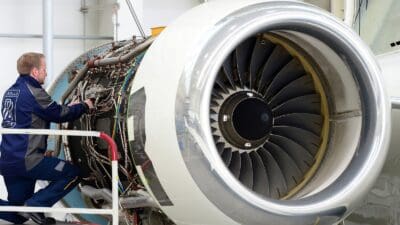2020 was a rough year for the Rolls-Royce (LSE:RR) share price. After crashing by nearly 50% in March, the stock continued its downward trajectory until early October.
The business serves multiple industries. But around half of its income comes from the sale and maintenance of aircraft engines. When travel restrictions prevented planes from taking off, a large portion of its revenue stream evaporated. So seeing the stock collapse is not that surprising to me. But is that all about to change? And should I be adding this business to my portfolio?
The recovery starts
In October last year, the Rolls-Royce share price reached its lowest point since 2003. But since then, it’s been on the rise. In fact, it’s up by around 165% over the last seven months. What’s causing this growth?
The business managed to secure a £5bn rescue package that brought it back from the brink of bankruptcy. Meanwhile, with the vaccine rollout progressing relatively quickly, it looks like the airline sector is finally starting to take off again. Here in the UK, holiday travel is on track to return later this month. And domestic flights in the US and China are already increasing.
This is undoubtedly good news for Rolls-Royce, and so seeing its share price rise as more planes return to the sky is understandable.
It’s worth remembering that initially, the majority of resumed flights are likely to be short-haul, and the firm’s engines are generally used on long-haul aircraft. So it may take a while longer before Rolls-Royce sees its revenue making a complete recovery. But based on current forecasts, it is expected to return to profitability by 2022. And with the worst seemingly over, it looks like a potential turning point for the business.
The risks that lie ahead
The return of travel is an encouraging sign. But even after the pandemic comes to an end, Rolls-Royce will still have many challenges to overcome, the first of which is its debt. As it stands, it has around £7.3bn of loan obligations on its balance sheet. That racks up a pretty expensive interest bill, and with no operating profits at this time, the firm is having to burn through cash to keep up with payments.
Needless to say, over the long term, this is unsustainable. And if it’s not able to return to profitability in 2022 as planned, I think it’s likely that the company will need to raise additional capital. Naturally, this will likely hurt the Rolls-Royce share price.
The management team has announced its intentions to dispose of non-core assets to build up its cash balance. However, its latest attempt to sell its Bergen Engines subsidiary failed after the Norwegian government blocked the transaction out of national security concerns. And with the currently weak market sentiment, it could take some time before another buyer is found.

The bottom line
The return of international travel does make me cautiously optimistic about the Rolls-Royce share price. However, I think its recovery will be a multi-year process, during which many things could go wrong.
Personally, I don’t believe the risk is worth the potential reward, especially since there are other more promising investment opportunities available today. I won’t be adding this stock to my portfolio.







